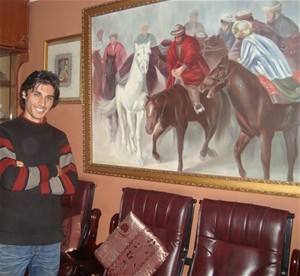
Kabir Ramz is an artist who creates oil paintings on large canvases. When Kabir was an art student at Kabul University before the days of stable electricity, he woke early in the morning to take advantage of the light to choose the right colors for his pa
USAID/AIRP
USAID energy programs bring 24-hour power to Kabul and a better life for a local artist.
“Now we can breathe where we want. I am busier now than when there was no electricity.”—Kabir Ramz
13 JUNE 2010 | KABUL, AFGHANISTAN
Art may not spring to mind as a beneficiary of improved energy in Afghanistan. However, the availability of 24-hour electricity in Kabul, through USAID, is benefiting the efforts of a young artist.
Kabir Ramz is a visual artist who paints large oil canvases. As an art student at Kabul University several years ago, Kabir was so committed to his work that he would rise early every morning to take advantage of the dawn’s light. Making his way to the university campus, he would arrive before classes to paint and sketch.
In those days, electricity was erratic at best.
At night, his only option for power was a small generator in the apartment where he lived with his family. “With oil painting, I needed normal light to choose the right colors,” he said. “The generator was bad, disturbing the neighbors and filling the house with smoke.”
After his classes in the afternoon, Kabir worked as a designer for a sign and billboard company. There, a high-voltage generator powered the sensitive machines that produced stainless steel, acrylic, and brass sign boards. “I did that for four years,” Kabir said. “When there was no electricity, everything shut down.”
Today, as a result of USAID energy programs, multiple sources of steady electricity power Kabul, including electricity imported from neighboring countries and hydropower. A new 105-megawatt power plant, built on the outskirts of Kabul by USAID’s Afghanistan Infrastructure Reconstruction Program, provides 20 percent of Kabul’s peak electricity.
Life for Kabir has improved significantly since his student days. The sign company where he still works has pioneered neon billboards and no longer relies on generators. He has city power at home in the evenings. And if Kabir needs to check something on the internet, he switches on his personal computer.
Kabir describes the difference as only an artist might. “Now we can breathe where we want,” he said. “I am busier now than when there was no electricity.”







Comment
Make a general inquiry or suggest an improvement.